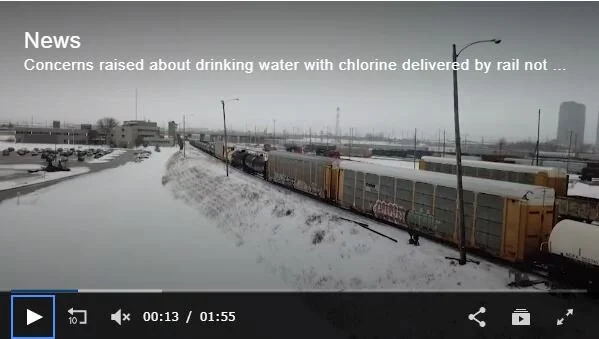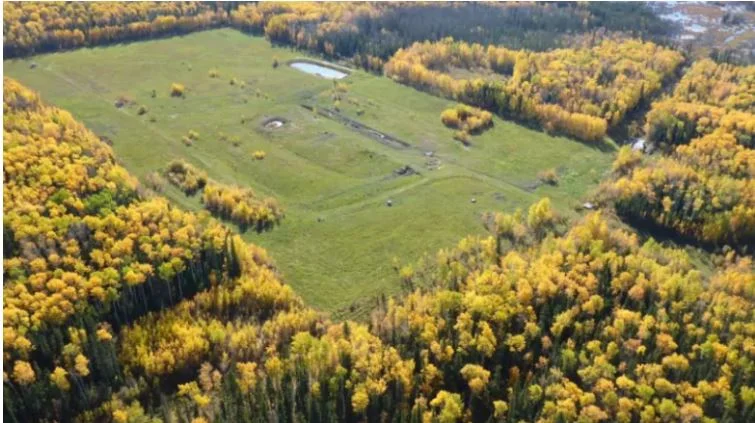It confirmed this week that legionella had been detected in three cooling towers at the building, and the air-conditioning system was shut down Wednesday. Tests came back negative after the system was shock-cleaned with chlorine, said a followup note to staff Friday, also obtained by Radio-Canada. The temperatures on the three days when the air conditioning was off ranged from about 27 C to 32 C in Bathurst, according to Environment Canada. Drinking water at the hospital also tested negative, according to the second message to hospital staff.
Mike ChaarSTAFF eat and drink I Tested 7 Bottles Of Water Sold In Canada & There's One I'll Be Avoiding
I put seven of Canada's bottled water brands to the test to uncover the real composition of their contents. Although it's generally safe to consume bottled water in our nation, I wanted to dig deeper. The question is not just about safety, but about which brands offer the best quality, and which ones you might be better off avoiding. I opted for some of the most popular brands including Flow, Nestlé Pure Life, Smartwater, Aquafina, Naya, Dasani and Eska.
Osoyoos’s drinking water to get a $9-million upgrade
The project will include the construction of a raw-water line to treat groundwater in Osoyoos, which is not currently treated and is high in manganese. The province said these upgrades will allow the water to be properly disinfected with chlorine and ultraviolet systems. The upgrades are expected to meet the Guidelines of Canadian Drinking Water Quality and Interior Health’s drinking water standards.
How solar-powered technology could enhance rainwater harvesting in Mexico
Research from a U of T Engineering team could help support household access to safe drinking water in low and middle-income communities by adopting solar-powered ultraviolet (UV) LED illumination to treat water in Mexico’s rainwater harvesting systems. The team includes Mistelle Haughton (CivMin MASc candidate), Karlye Wong (CivMin PhD candidate) and Professor Ron Hofmann (CivMin). Together, they are among a handful of researchers focusing on the benefits of UV LEDs for water harvesting systems.
Media Based Water Filters World Market Statistics | Focus On Estimation, Research and Future Growth by 2033
The media-based water filter market is expected to grow at a significant rate due to the increasing awareness about water pollution and the need for clean and safe drinking water. The market is driven by the increasing demand for clean water, especially in developing countries, and the growing awareness about water-borne diseases. In terms of product type, the market can be segmented into activated carbon filters, sand filters, and multimedia filters. Activated carbon filters are expected to dominate the market due to their ability to remove chlorine, chloramines, and other volatile organic compounds.
Chlorine prompts boil water advisory in Gjoa Haven
A precautionary boil water advisory has been issued in Gjoa Haven, Nunavut, because of inconsistent chlorine levels at the community's water treatment plant, according to the territory's health department. Health officials say all water that's being consumed should be boiled for at least a minute. That includes water being used to wash fruits and vegetables, to cook, and to brush teeth. The department says it'll let the community know when the advisory has lifted.
Explain like I’m 5: How did fuel make it into Iqaluit’s water supply?
The fuel contamination of Iqaluit’s water supply left people asking a lot of questions, not least of which was — how did it get there in the first place? Answering this question was one requirement among a longer list of must-dos before the territory’s chief public health officer, Dr. Michael Patterson, would consider telling people the city’s water was safe to drink again after diesel fuel was detected in the city’s water system in October. Patterson did lift the do-not-consume water advisory on Dec. 10, nearly two months after it was imposed on Oct. 12. The original suspect was a crack in one of two underground holding tanks at Iqaluit’s water treatment plant, where water sits in chlorine before moving into a treated reservoir, called the North Clear well.
Sask. dental public health expert debunks myths, misinformation about community water fluoridation
"It's just like the chlorine in drinking water. In the right concentration it is protective because it purifies the water, but in a certain concentration chlorine gas has been used in wars because it's deadly." A character in the 1964 movie Dr. Strangelove believed communists were adding fluoride to American water and called it the “the most monstrously conceived and dangerous communist plot” they’ve ever had to face. The movie, which satirizes the Cold War, pokes fun at the thought of water fluoridation being used as a weapon of war.
NP View: That many First Nations still don’t have access to potable water is a stain on our national character
It is to our national shame that many First Nations communities still don’t have access to potable water. That we have known about the problem for decades and failed to address it is a stain on our national character — one that Justin Trudeau and his Liberals made a lot of hay about addressing during the 2015 election campaign. “A Canadian government led by me will address this as a top priority because it’s not right in a country like Canada. This has gone on for far too long,” Trudeau said at the time, pledging to end all boil-water advisories on reserves within five years.
Is it safe to swim in a pool during the COVID-19 pandemic?
As temperatures across Canada continue to rise, few things do a better job of keeping us cool than going for a swim. But with the closure of public swimming pools across the country due to the COVID-19 pandemic, many may be left wondering how safe it will be to return to these spaces once they reopen. According to Matthew Miller, a biochemistry professor at McMaster University in Hamilton who is studying the novel coronavirus, COVID-19 is highly unlikely to be transmitted through water.
Rural N.L. towns struggling to pay mounting costs of clean drinking water
On any given day in Newfoundland and Labrador, there are about 200 boil-water advisories in place in rural communities — and it's not only a problem of public health, but of the viability of small towns themselves. Governments have known for decades the seriousness of the situation, but the problem persists, for several reasons, starting with cost.
Concerns raised about drinking water as chlorine delivered by rail held up by blockades
Hundreds of freight trains are at a standstill across Ontario, not moving because of ongoing rail blockades. One organization has now raised concerns about the impact it could have on drinking water since the chemicals needed to treat it are transported by rail. “We are very concerned actually,” says Cathy Campbell, president of Responsible Distribution Canada. Campbell says large cities and municipalities could run out of chlorine in a week or two.
Decontaminating pesticide-polluted water using engineered nanomaterial and sunlight
QUÉBEC, Jan. 15 2020 /CNW Telbec/ - Atrazine is one of the most widely used pesticides in North America. Researchers at the Institut National de la Recherche Scientifique (INRS) have developed a new method to degrade it that combines a new nanostructured material and sunlight. Atrazine is found throughout the environment, even in the drinking water of millions of people across the country. Conventional water treatments are not effective in degrading this pesticide. Newer processes are more effective, but use chemicals that can leave toxic by-products in the environment.
Brown tap water causing concern in Langley Township
The brown water flowing from the taps in the Murrayville neighbourhood of Langley Township has some of the residents worried for their health and safety. Photos posted to the community Facebook page show drinking glasses, a sink and a hot tub full of foul-looking water. "None of us trust it and no one in their right mind would want to drink water that looks like that," said Krystal Woodward in a message to CBC News.
Neskantaga First Nation evacuees can return home, officials say
Evacuees from Neskantaga First Nation started returning home Monday after recent water testing showed chlorine and microbiological levels were at acceptable levels after a new pump was installed in the local water system. The previous piece of equipment malfunctioned earlier in September, triggering a state of emergency. About 220 residents were in Thunder Bay for more than a week after the pump went down on Sept. 14. Chief Chris Moonias called for the evacuation himself, concerned about symptoms he said were showing up in community members, including skin rashes, stomach problems and headaches.
West-coast water foragers turn off their taps—and go straight to the source
Once a month, Susan Chipman drives to a mountainside spring that burbles from the ground in North Vancouver and fills four 20-litre containers with water to use for drinking and cooking. When full, each container weighs 20 kg. Chipman lives on the top floor of a three-storey walk-up apartment in Vancouver. Her building has running water, of course, supplied and sourced by Metro Vancouver from protected reservoirs even higher up in the North Shore Mountains. But it lacks an elevator. So, she hauls her water jugs up the stairs, one in each hand for balance. “It’s a bit of a chore in the true sense of the word, but it’s worth it, I think.” Chipman says she was hooked from the first sip. She tasted it and thought, “OK, this is real water.”
Suspected toxic leak triggers water licence application for N.W.T. well-site cleanup
The company responsible for cleaning up a defunct natural gas field near Fort Liard, N.W.T., says it will apply for a water licence after the territory's environmental regulator found chloride from the site is causing damage to the surrounding environment. In a June 5 letter to Paramount Resources, Environment and Natural Resources water resource officer Sonja Martin-Elson said that an inspection conducted last summer at the shuttered Pointed Mountain site found the company was in violation of the territory's Waters Act.
Spring run-off to blame for Edmonton's smelly tap water
If your tap water smells like chlorine, your schnozz has sniffed out a common springtime phenomenon in Edmonton. The spring thaw has made the city's drinking water more pungent than usual. Run-off from melting snow and river ice has washed higher than normal volumes of organic material into the water supply, said Shane Harnish, Epcor's senior manager of analytical operations. It's something workers at Edmonton's water treatment plants contend with every year. "What you're noticing is the chlorine smell in our water, and it's due to the chlorine reacting with some of this organic material," Harnish said in an interview Wednesday with CBC Radio's Edmonton AM.




















